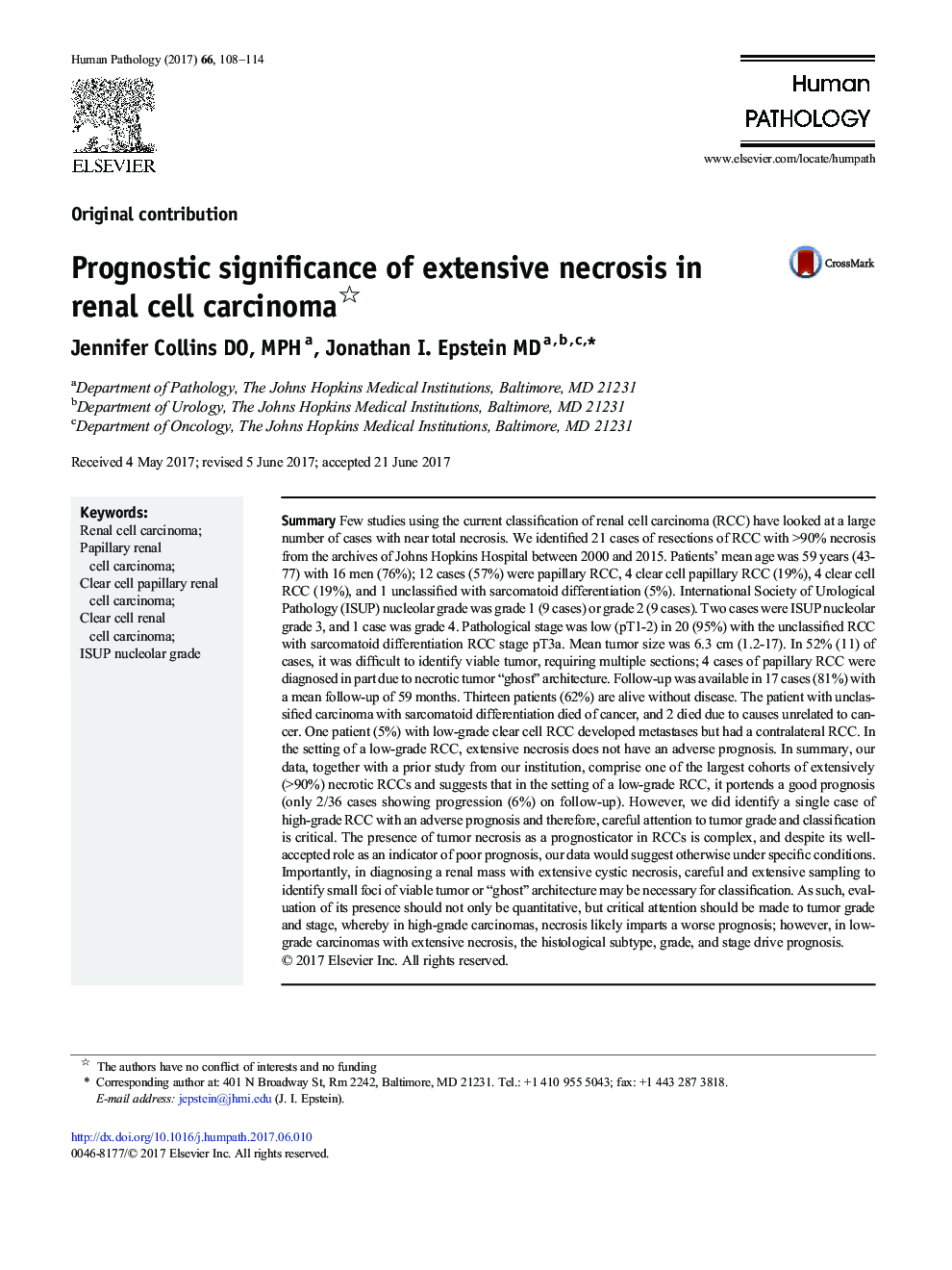| کد مقاله | کد نشریه | سال انتشار | مقاله انگلیسی | نسخه تمام متن |
|---|---|---|---|---|
| 5716124 | 1606644 | 2017 | 7 صفحه PDF | دانلود رایگان |

- Our data suggest that extensive necrosis in the setting of a low-grade RCC portends a good prognosis.
- An extensively necrotic renal mass requires thorough sampling for “ghost” architecture.
- Careful attention to tumor grade, classification, and stage is critical in the presence of extensive necrosis.
- In high-grade RCC, necrosis imparts a worse prognosis.
- In extensively necrotic low-grade RCC histologic subtype, grade and stage drive prognosis.
SummaryFew studies using the current classification of renal cell carcinoma (RCC) have looked at a large number of cases with near total necrosis. We identified 21 cases of resections of RCC with >90% necrosis from the archives of Johns Hopkins Hospital between 2000 and 2015. Patients' mean age was 59 years (43-77) with 16 men (76%); 12 cases (57%) were papillary RCC, 4 clear cell papillary RCC (19%), 4 clear cell RCC (19%), and 1 unclassified with sarcomatoid differentiation (5%). International Society of Urological Pathology (ISUP) nucleolar grade was grade 1 (9 cases) or grade 2 (9 cases). Two cases were ISUP nucleolar grade 3, and 1 case was grade 4. Pathological stage was low (pT1-2) in 20 (95%) with the unclassified RCC with sarcomatoid differentiation RCC stage pT3a. Mean tumor size was 6.3 cm (1.2-17). In 52% (11) of cases, it was difficult to identify viable tumor, requiring multiple sections; 4 cases of papillary RCC were diagnosed in part due to necrotic tumor “ghost” architecture. Follow-up was available in 17 cases (81%) with a mean follow-up of 59 months. Thirteen patients (62%) are alive without disease. The patient with unclassified carcinoma with sarcomatoid differentiation died of cancer, and 2 died due to causes unrelated to cancer. One patient (5%) with low-grade clear cell RCC developed metastases but had a contralateral RCC. In the setting of a low-grade RCC, extensive necrosis does not have an adverse prognosis. In summary, our data, together with a prior study from our institution, comprise one of the largest cohorts of extensively (>90%) necrotic RCCs and suggests that in the setting of a low-grade RCC, it portends a good prognosis (only 2/36 cases showing progression (6%) on follow-up). However, we did identify a single case of high-grade RCC with an adverse prognosis and therefore, careful attention to tumor grade and classification is critical. The presence of tumor necrosis as a prognosticator in RCCs is complex, and despite its well-accepted role as an indicator of poor prognosis, our data would suggest otherwise under specific conditions. Importantly, in diagnosing a renal mass with extensive cystic necrosis, careful and extensive sampling to identify small foci of viable tumor or “ghost” architecture may be necessary for classification. As such, evaluation of its presence should not only be quantitative, but critical attention should be made to tumor grade and stage, whereby in high-grade carcinomas, necrosis likely imparts a worse prognosis; however, in low-grade carcinomas with extensive necrosis, the histological subtype, grade, and stage drive prognosis.
Journal: Human Pathology - Volume 66, August 2017, Pages 108-114